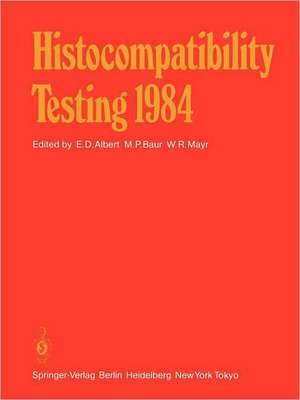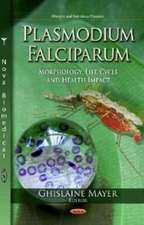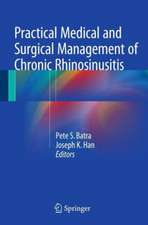Histocompatibility Testing 1984: Report on the Ninth International Histocompatibility Workshop and Conference Held in Munich, West Germany, May 6–11, 1984 and in Vienna, Austria, May 13–15, 1984
Editat de E.D. Albert, M.P. Baur, W.R. Mayren Limba Engleză Paperback – 20 noi 2011
Preț: 769.64 lei
Preț vechi: 810.15 lei
-5% Nou
Puncte Express: 1154
Preț estimativ în valută:
147.29€ • 159.93$ • 123.72£
147.29€ • 159.93$ • 123.72£
Carte tipărită la comandă
Livrare economică 22 aprilie-06 mai
Preluare comenzi: 021 569.72.76
Specificații
ISBN-13: 9783642697722
ISBN-10: 3642697720
Pagini: 796
Ilustrații: XXVIII, 764 p.
Dimensiuni: 210 x 280 x 42 mm
Greutate: 1.76 kg
Ediția:1984
Editura: Springer Berlin, Heidelberg
Colecția Springer
Locul publicării:Berlin, Heidelberg, Germany
ISBN-10: 3642697720
Pagini: 796
Ilustrații: XXVIII, 764 p.
Dimensiuni: 210 x 280 x 42 mm
Greutate: 1.76 kg
Ediția:1984
Editura: Springer Berlin, Heidelberg
Colecția Springer
Locul publicării:Berlin, Heidelberg, Germany
Public țintă
ResearchCuprins
Introductory Remarks.- Nomenclature for Factors of the HLA System 1984.- Joint Reports.- The HLA System, 1984.- HLA at the Gene Level.- Biochemistry of Class II Antigens: Workshop Report.- The Central Data Analysis of the Ninth Workshop.- Analysis of Multilocus Pedigree Data by Computer.- PEDPLO: The Pedigree Plot Program.- Cell Typing by Computer.- Unbiased Serum Analysis.- Selection of a Set of High-Quality Data for B Cell Antigen Analysis.- The Serological Analysis of the Data of the Ninth Histocompatibility Workshop.- Analysis of HLA-DR Typing sera Used in the Workshop Transplant Study.- Antigen Reports.- HLA-A1.- HLA-A2.- HLA-A3.- HLA-A11.- HLA-A23.- HLA-A24.- A9.3.- HLA-A25.- HLA-A26.- HLA-A28.- HLA-A29.- HLA-A30 HLA-A31.- HLA-A32.- HLA-Aw33.- HLA-Aw34.- HLA-Aw36.- HLA-Aw43.- HLA-Aw66.- TH.- HLA-B7.- HLA-B8.- HLA-B13.- HLA-B14: Definite Splitting into Bw64 (14.1) and Bw65 (14.2).- HLA-B18.- HLA-B27.- HLA-B35.- HLA-B37.- HLA-B38.- HLA-B39.- HLA-BW41.- HLA-BW.- HLA-B44.- HLA-B45.- HLA-BW46.- HLA-BW47.- HLA-BW48.- HLA-B49.- HLA-Bw50.- HLA-B51 and HLA-Bw52.- HLA-BW53.- HLA-BW54, HLA-BW55, and HLA-BW56.- HLA-BW57.- HLA-BW58.- HLA-Bw59.- HLA-BW60.- HLA-BW61.- HLA-Bw62 and Other Bw6-Associated Variants of B15.- HLA-Bw63 and Other Bw4-Associated Variants of B15.- HLA-Bw67.- HLA-Bw70, HLA-Bw71, and HLA-Bw72.- HLA-Bw73.- HLA-Bw4 and HLA-Bw6.- HLA-CWL.- HLA-CW2.- HLA-CW3.- HLA-CW4.- HLA-CW5.- HLA-CW6.- HLA-CW7.- HLA-CW8.- NEW HLA-C.- HLA-DR1.- HLA-DR2.- HLA-DR3.- HLA-DR4.- HLA-DR5 and Its Subtypes HLA-DRwl 1 and HLA-DRwl2.- HLA-DRW6 and Its Subgroups HLA-DRWL3 and HLA-DRWL4.- HLA-DR7.- HLA-DRW8.- HLA-DRW9.- HLA-DRWL0.- HLA-DRW52.- HLA-DRW53.- New HLA-DR.- HLA-DQWL.- HLA-DQW2.- HLA-DQW3.- Reports on Monoclonal Antibodies.- HLA-A, B, C Monoclonal Antibodies.- HLA-D Region Monoclonal Antibodies.- Special Serology Reports.- HLA-A, B, Interlocus Specificities.- Specificity of The Ninth Workshop Anti la Alloantisera As Assessed by The Direct Binding Assay.- HLA-DR, DQ, and DW Relationships.- HLA-DR, DQ, LB, and TA10 Specificities of Ninth Workshop Homozygous Typing Cells.- Cellular Part: Homozygous Typing Cells (HTC).- Definition of HLA-D with HTC.- Segregation Analysis (HTCS).- First Level Testing of HLA-DR4-Associated New HLA-D Specificities: DWL3 (DB3), DWL4 (LD40), DWL5 (DYT), and DKT2.- First Level Testing of DW6 HTC.- First Level Testing of DW7 HTC.- First Level Testing of DW8 HTC.- First Level Testing of HLA-D “Blank” HTC.- DNA Restriction Fragment Length Polymorphism of Some Ninth Workshop Homozygous Typing Cells Using a cDNA Probe Specific for DRß.- Cellular Part: Primed Lymphocyte Typing (PLT).- Genetic Analysis of HLA-D Region Products Defined by PLT.- Segregation Analysis of PLT Reagents in Families.- Median Stabilization of PLT Data for the Central Workshop Analysis.- Origin and Expansion of SB (DP)-Specific Reagents Characterized in the Ninth International Workshop.- Cellular Part: Cell-Mediated Lympholysis (CML).- CML: A Method for Cellular Typing.- Complement Polymorphisms.- The Second Complement Component, C2, in the Ninth Workshop.- Properdin Factor B.- C4 Polymorphism.- Genetics of HLA.- Analysis of MHC Recombinant Families.- Linkage Between HLA-A, C, B, Bf and DR Alleles: Haplotype Study of Healthy Families by Factorial Correspondence Analysis.- The Nature of Selection in the HLA Region Based on Population Data From the Ninth Workshop.- Population Analysis on the Basis of Deduced Haplotypes from Random Families.- Ninth International Histocompatibility Workshop Renal Transplant Study.- Disease Reports.- Insulin-Dependent Diabetes Mellitus.- HLA-DR3 and DR7-Negative Celiac Disease.- Leprosy.- Juvenile Chronic Arthritis, Pauciarticular Type.- A Family Study of Gold-Induced Nephropathy in Patients with Rheumatoid Arthritis.- Rheumatoid Arthritis.- D-Penicillamine-Induced Myasthenia Gravis.- HLA-B27-Negative Ankylosing Spondylitis.- Scleroderma: Possible Association with the C4 System - A Progress Report.- Beh?et’s Disease.- Kawasaki Disease (Mucocutaneous Lymph Node Syndrome).- Classical and AIDS Kaposi’s Sarcoma.- HLA and Familial Malignant Melanoma.- Hodgkin’s Disease.- Original Contributions.- Serology.- Human Histocompatibility Antigens in Malignant Tumors of Nonlymphoid Origin.- B27 Subtypes.- Segregation of DQ and DR: “Exceptions to the Rule”.- Characterization of a New Subset of B Cell Alloantigens.- Serologic Detection of New Polymorphisms on DQ Molecules Distinct from the DQw1, 2, and 3 Specificities.- Analysis of 9W Antisera Detecting DR4- and DR2-Associated Epitopes by Use of Anti-idiotypic Antibodies.- The HLA-D Region: Serology, Structure, Tissue Distribution, and Function of Human Class II Molecules and Their Antigenic Determinants.- Definition of MCI, a Novel HLA Determinant Associated with DR1 and DR4.- A Monoclonal Antibody (GH-3): “Non-orthodox” Anti-HLA-A3 or A11 Induced by a Lymph Node Extract from a Hodgkin’s Disease Patient.- Enhancing Monoclonal Antibodies Against HLA-Bw4 Molecules.- Spatial Localization of Allospecific HLA Class I Epitopes by Antibody Blocking Studies.- Analysis of Homozygous Typing Cells with Primed Lymphocytes and Monoclonal Antibodies Directed Against Polymorphic la Antigen Epitopes.- A Monoclonal Antibody Detects a New Antigenic Determinant Shared by DR1 and DR4/Dw4 Molecules.- Serological Analysis of Two Monoclonal Antibodies: One Detecting an DRw53 Supertypic Determinant and One Detecting a New Supertypic Determinant Related to HLA-DR7.- Study of Monoclonal Antibodies to the HLA-D Region Products DQW1 and DRw52.- Characterisation of the HLA-D Region DQw3 Specificity Using the Monoclonal Antibodies 2HB6 and IVD12.- Idiotypic Analysis of Anti-Human MHC Class II Monoclonal Antibodies by Syngeneic Anti-Idiotypes.- Comparison of Human-Human and Human-Mouse Hybridoma Systems for the Production of Alloreactive Human Monoclonal Antibodies.- Crossreactivity of Monoclonal Anti-HLA Antibodies with Rhesus Monkey Lymphocytes.- A Simple and Rapid Procedure for Purification of Human Dendritic Cells From Peripheral Blood.- HLA-A, B, C Typing Using Serum.- Definition of Two Monocyte-Specific Antigens, One of Which Correlates with the 9 a Antigen.- Anti-Idiotypic Antibodies in Women with Successful Pregnancy.- T-Cell Alloantigens.- Class I MHC-Linked Determinants Expressed on Activated T Cells.- Alloantibodies to PHA-Activated Lymphocytes Detect Human QA-Like Antigens.- T Cell System A in Humans is Probably Equivalent to Qa or Tla in Mice.- New Determinants Expressed on Activated Lymphocytes and on Human Acute Lymphoblastic Leukemia Cells Closely Linked to Conventional HLA-A Antigens.- Cellular Definition of HLA Antigens.- Analysis of DP Region Products by T Cells and Monoclonal Antibodies:Blocking of DP-Specific Proliferation and Cell-Mediated Cytotoxicity.- Typing for DP-like Determinants.- LB-Q1 and LB-Q2: Population Genetics in Dutch Caucasoids and Inhibition Studies with Monoclonal Antibodies.- Allelic Class II Determinants Defined by PLT Typing.- HLA-D and DR in Different Populations.- Private Specificities of Human IA-Like Molecules Detected by T Cell Lines.- PLT Analysis of D Region Complexity by Cloned Cells: A New Non-DP Antigen.- Correlation Between PLT and CML Specificity of Alloreactive TCell Clones.- Heterogeneity of DR5-Associated Alloantigens Detected by Human T Lymphocyte Clones.- Heterogeneity of HLA-B7 as Detected by Cytotoxic T Cell Clones.- Analysis of Cytolytic Clones Directed at Class I and Class II Antigens Using HLA Loss Mutants of a Lymphoblastoid Cell Line.- HLA Mutants of Lymphoblastoid Cell Lines: Generation of New Mutants and Analysis by Southern Blotting.- Mutant Cell Lines as Means of Resolving HLA Gene Products.- Human T Cell Clone Inhibition by Distinct Monoclonal Anti-HLA-DR Antibodies.- Variation in the Epitopes on the HLA-A2 Molecule as Recognized by HLA-A2 Restricted and Alloimmune HLA-A2-Specific Cytotoxic T Lymphocytes.- Cloned Cytotoxic T Cells Which May Define a Minor Transplantation Antigen and a Variant of the HLA-B8 Molecule.- Construction and Expansion of CTLs for HLA Typing: Definition of B44 Subtypes by Cellular Typing.- Frequencies of Proliferative and Cytotoxic Precursor T Cells During a Course of Active Immunization as Analysed by Limiting Dilution.- HLA Class II Alloantigens Defined by Cytotoxic T Cell Clones and Monoclonal Antibodies.- Biochemistry of HLA Antigen.- Structural Analysis of the Polymorphism of HLA Class I Antigens.- Molecular and Functional Analysis of Class II Molecules Characteristic to HLA-Dw2 and Dwl2.- Two-dimensional Gel Analysis of DR2 and DQwl Molecules Isolated from Dw2 and Dwl2 Homozygous Cell Lines.- Separation of Three Human B-Cell Alloantigens, DR4, DRw53, and DQw3 (TB21), by Two-dimensional Gel Electrophoresis: Comparison of Alloantibodies and Monoclonal Antibodies.- Serological and Structural Heterogeneity of HLA-DR4 Alloantigens.- Molecular Polymorphism of DR and DQ Products.- Structural Polymorphism in DQw3 Light Chains.- Molecular Dissection of DRw6.- Heterogeneity of HLA Class II Gene Products as Studied in a Family by Sequential Immunoprecipitation.- A Supertypic DRw53 Determinant is Carried on the HLA-DR Subset of Class II Molecules on HLA-DR7 Cell Lines n.- The Molecular Complexity of DR7-Associated la Molecules.- Alloantisera and Monoclonal Antibodies Which Appear to Define the Same la Allospecificity in Population Studies Do Not Detect the Same la Molecules in Biochemical Studies.- The Polymorphism of DQ (DC) Molecules.- Comparison of Supertypic Specificities by Cytotoxicity and by Radioimmunoassay in Segregating Families.- HLA-FA: A Non-DR, Non-DQ HLA Class II Product.- Hybrid HLA-DQ Antigens: Molecular Expression.- Nonassociated HLA-DR ? and ? Chains: Molecular Detection and Differential Cellular Expression.- The Expression of HLA-DR, DQ and DP Antigens on the Surface of Lymphocytes as Assessed by 2-D Polyacrylamide Gel Analysis of Immunoprecipitates.- Preferential Increase of Expression and Release of DQ Molecules in Human Cells Treated with Interferons.- Differential Molecular Expression of HLA-DR and HLA DQ Antigens in Leukemic Cells.- Analysis of HLA Genes at the DNA Level.- HLA Class I Gene Typing with an HLA-B-Specific DNA Probe.- A Study of HLA-B-Locus Polymorphism with a Specific Hybridization Probe.- HLA Gene Polymorphisms: Class I.- HLA Gene Polymorphism: Class II.- Association of Class I and Class II MHC Restriction Fragment Polymorphism with HLA-Related Diseases.- Cloning and Expression of the Gene Encoding HLA-A11.- Isolation and Characterization of the cDNA Clones and the Genomic Clones of the HLA Class II Antigen Heavy Chains.- DNA Polymorphism of HLA-DR? and HLA-DP? Genes.- Molecular Complexity of the HLA-DR, DQ, and DP Genes and Genotypic Split of HLA-DR Serological Specificities by “DNA Typing”.- HLA Class II Polymorphism: Restriction Fragment Patterns Correlated to Ninth Workshop Serology and Function.- HLA-DRw6: A Molecular Approach.- Molecular Analysis of HLA: Haplotype-Specific DNA Hybridization Patterns Using Class II cDNA Probes.- Analysis and Segregation of HLA-DR by DNA Typing: Correlation with Supertypic Specificities.- Recombinant DNA Technology: Its Use in the Study of HLA.- HLA-DR and DQ, Studied with Genomic Blotting, in Diabetic Families and Transplant Donor-Recipient Pairs.- DNA Restriction Fragment Length Polymorphism of the Human Class II Genes as Analyzed by Southern Blotting Technique.- Mouse L Cells Expressing Human HLA-DR Antigens After Transfection with Class II Genes Do Not Stimulate Human T Lymphocytes.- Modification of Immunogenicity of Leukaemic Cells by DNA Mediated Gene Transfer.- Genetics of HLA.- Precise Location of HLA Genes on Chromosome 6.- A Structural Locus for Coagulation Factor XIIIA (Fl3A) Is Located Distal to HLA on the Short Arm of Chromosome 6 in Man.- The Selective Origin of Linkage Disequilibrium in the HLA Region.- HLA-A, B Genes in the World and the Effect of Climate.- Glyoxalase I (GLO I) Phenotyping by Isoelectric Focusing.- Complement Polymorphisms.- C4 Haplotypes with Duplicated C4A or C4B: Frequency and Associations with Bf, C2, and HLA-A, B, C, DR Alleles with Special Reference to the Duplication C4B1,2.- Gene Duplication of C4A in the Lancaster County, Pennsylvania, Old Order Amish: C4A*2A*3 is in Coupling with HLA A3, Cw4, B35, BfF, DR1, GL02.- Distinct Complotypes Are Associated with HLA-B14 Subgroups.- Bf Polymorphism Studied by Isoelectrofocusing.- >Function of HLA Gene Products.- Genetic Control of HLA-Linked Immune Responsiveness to Synthetic Polypeptides in Healthy Individuals and Patients with Autoimmune Diseases.- HLA-Linked Immune Suppression Genes: A Mechanism for the Statistical Association Between HLA and Disease.- Effects of Anti-DQ (MB) and Anti-DR Monoclonal Antibodies on In Vitro Immune Responses.- Individual Differences in the In Vitro (CTC) Immune Response to HLA Antigens.- HLA-Linked Gene Regulation of the Immune Response to Nitrofurantoin-Albumin.- Phenotype and Specificity of MLR-Generated Suppressor Cells.- Alloproliferative T4+ T8- Human T Cell Clones with Suppressive, Not Helper, Function.- Relationship Between the OKT Phenotype of Alloreactive Human T Cell Clones and Their Specificity for HLA Class II Antigens.- Functional Heterogeneity of Human T Cell Responses to Class I and Class IIMHC Antigens.- Restriction of Human Influenza A Virus-Specific T Cell Clones by HTC-Defined Subtypes of HLA-Dw6.- Antigen-Specific T Cell Clones Restricted by DR, DQ, or DP Class II HLA Molecules.- HLA-DR Typing by Restriction Specificity. A Functional Approach Using PPD-Specific CTLs and Antigen Presenting Monocytes.- Cytotoxic T Cells Generated During GvHD Can Detect Minor Histocompatibility Antigens in an HLA-Restricted Fashion.- Clonal Distribution of Human T Cells Recognizing PPD in the Context of Each of Two Distinct la Molecules.- Function of DRw52 and LB-Q1 in Antigen Presentation.- Subdivision of DRw6 by Influenza-Specific Proliferative Cloned Cell Lines.- Human T Cell-Mø Collaboration Across Allogeneic Barrier.- Expression of HLA-DQ Molecules on Human Monocytes: Identification of Two Phenotypically Different Monocyte Populations with Distinct Accessory Cell Function.- Differential Expression of the HLA-DQ Antigens on Acute Leukaemic Blasts.- Expression of HLA Class II Molecules on Human Monocytes and Dendritic Cells.- Absence of DQwl on Monocytes Depending on the DR Antigens Expressed.- Interaction Between HLA Class I Antigens and ?-Endorphin.- The Major Histocompatibility Complex as an Antibiosenescent System.- HLA and Disease.- Defective Expression of HLA-D-Region Determinants in Children with Congenital Agammaglobulinemia and Malabsorption: A New Syndrome.- Defect of Expression of MHC Genes Responsible for an Abnormal HLA Class I Phenotype and the Class II Negative Phenotype of Lymphocytes from Patients with Combined Immunodeficiency.- Inheritance and Possible Coinheritance of HLA-Linked Susceptibilities to Insulin-Dependent Diabetes Mellitus, Autoimmune Thyroid Diseases, and Rheumatoid Arthritis.- Genetic Polymorphism of the Fourth Component of Complement (C4)- and Type I Insulin-Dependent Diabetes.- Presence of Thyroid-Stimulating Immunoglobulins (TSI) in DR3 Positive Normal Individuals.- Three Different HLA Associations in the Three Types of 21-Hydroxylase Congenital Adrenal Hyperplasia.- Distinct HLA-B Antigen Associations for the Salt-Wasting and Simple Virilizing Forms of Congenital Adrenal Hyperplasia Due to 21 -Hydroxylase Deficiency.- Defect of Ferritin Secretion in HLA-A3 Subjects and in Idiopathic Hemochromatosis.- Immunogenetic Analysis of Leprosy in Japan.- Affected Sib Methods.- Genetic Interrelationship Amongst HLA-Associated Diseases.- Is the Lod Score Method Reliable in HLA-Associated Diseases?.- HLA-DR, Gm Allotypes and Sex as Risk Factors for Celiac Disease.- Transplantation.- The Relative Importance of MLC and HLA-DR Compatibility in Cadaver Kidney Transplantation.- Long-Term Follow-Up of London Transplant Group (LTG) Renal Transplant Patients.- The Influence of HLA-A, B Compatibility on Cadaver Donor Renal Transplantation in SEOPF.- Donor-Specific Blood Transfusion and Renal Graft Survival: A 3-Year Experience in Pediatrics.- Marrow Transplantation from Donors Other Than HLA Genotypically Identical Siblings: The Immunogenetics of Acute Graft Versus Host Disease.- Immunological Investigation of Patients Treated for Leukaemia by Bone Marrow Transplantation (BMT).- Chimerism Following Fetal Liver and Thymus Transplantation.- Annex.- Reference Tables of Two-Locus Haplotype Frequencies for All MHC Marker Loci.- Reference Tables of Three-Locus Haplotype Frequencies and Delta Values in Caucasians, Orientals, and Negroids.- Index of Authors.











